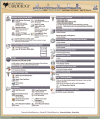Impact of electronic personal health record use on engagement and intermediate health outcomes among cardiac patients: a quasi-experimental study
- PMID: 26912538
- PMCID: PMC7814924
- DOI: 10.1093/jamia/ocv164
Impact of electronic personal health record use on engagement and intermediate health outcomes among cardiac patients: a quasi-experimental study
Abstract
Objectives: To determine the impact of tethered personal health record (PHR) use on patient engagement and intermediate health outcomes among patients with coronary artery disease (CAD).
Methods: Adult CAD patients (N = 200) were enrolled in this prospective, quasi-experimental observational study. Each patient received a PHR account and training on its use. PHRs were populated with information from patient electronic medical records, hosted by a Health Information Exchange. Intermediate health outcomes including blood pressure, body mass index, and hemoglobin A1c (HbA1c) were evaluated through electronic medical record review or laboratory tests. Trends in patient activation measure® (PAM) were determined through three surveys conducted at baseline, 6 and 12 months. Frequency of PHR use data was collected and used to classify participants into groups for analysis: Low, Active, and Super users.
Results: There was no statistically significant improvement in patient engagement as measured by PAM scores during the study period. HbA1c levels improved significantly in the Active and Super user groups at 6 months; however, no other health outcome measures improved significantly. Higher PAM scores were associated with lower body mass index and lower HbA1c, but there was no association between changes in PAM scores and changes in health outcomes. Use of the PHR health diary increased significantly following PHR education offered at the 6-month study visit and an elective group refresher course.
Conclusions: The study findings show that PHR use had minimal impact on intermediate health outcomes and no significant impact on patient engagement among CAD patients.
Keywords: and patient engagement.; coronary artery disease; health outcomes; patient activation measure; patient portal; personal health records.
© The Author 2016. Published by Oxford University Press on behalf of the American Medical Informatics Association. All rights reserved. For Permissions, please email: journals.permissions@oup.com.
Figures
References
-
- The Health Information Technology Resource Center . The value of personal health records and web portals to engage consumers and improve quality . Robert Wood Johnson Foundation . 2012. ; 1 – 9 . Available at : http://forces4quality.org/af4q/download-document/5596/Resource-value_of_... .
-
- United States Congress . Patient Protection and Affordable Care Act . Pub. L. No. 111-148, §2702, 124 Stat. 2010; 119, 318-319 .
-
- Hibbard JH, Greene J . Who are we reaching through the patient portal: engaging the already engaged? . Int J Pers Cent Med. 2011. ; 1 ( 4 ): 788 – 793 .
-
- Nagykaldi Z, Aspy CB, Chou A, et al. . Impact of a Wellness Portal on the delivery of patient-centered preventive care . J Am Board Fam Med. 2012. ; 25 ( 2 ): 158 – 167 . - PubMed
Publication types
MeSH terms
Substances
LinkOut - more resources
Full Text Sources
Other Literature Sources
Medical
Miscellaneous


